Adressing Energy Demand and Climate Change through the Second Law of Thermodynamics and LCA towards a Rational Use of Energy in Brazilian Households
Abstract
1. Introduction
2. Material and Methods
2.1. Residential Appliances
2.2. Supply Chains of Food, Electricity and Fuel
2.3. Water and Waste Management
3. Results and Discussion
3.1. Greenhouse Gas Emissions
3.2. Overall Exergy Analysis
3.3. Sensitivity Analysis of Electricity Consumption by the Household Appliances
4. Conclusions
Author Contributions
Funding
Institutional Review Board Statement
Informed Consent Statement
Data Availability Statement
Conflicts of Interest
References
- Empresa de Pesquisa Energetica (EPE). Brazilian Energy Balance 2020 Year 2019 (In Portuguese). 2020. Available online: https://inis.iaea.org/search/search.aspx?orig_q=RN:52083434 (accessed on 4 October 2022).
- Empresa de Pesquisa Energetica (EPE). Brazilian Energy Balance 2022 Year 2021 (In Portuguese). 2022. Available online: https://www.epe.gov.br/sites-en/publicacoes-dados-abertos/publicacoes/Paginas/Brazilian-Energy-Balance-2021.aspx (accessed on 4 October 2022).
- Empresa de Pesquisa Energetica (EPE). Brazilian Energy Balance 2021 Year 2020 (In Portuguese). 2021. Available online: https://www.epe.gov.br/sites-en/publicacoes-dados-abertos/publicacoes/Paginas/Brazilian-Energy-Balance-2020.aspx (accessed on 4 October 2022).
- INMETRO. ENCE-Etiqueta Nacional de Conservação de Energia: Selo PROCEL de Economia de Energia/ANEXO DA PORTARIA INMETRO Nº 410/2013. Available online: http://www.inmetro.gov.br/legislacao/ (accessed on 4 October 2022).
- Mady, C.E.K.; Reis Pinto, C.; Torelli Reis Martins Pereira, M. Application of the second law of thermodynamics in brazilian residential appliances towards a rational use of energy. Entropy 2020, 22, 616. [Google Scholar] [CrossRef] [PubMed]
- Dincer, I. The role of exergy in energy policy making. Energy Policy 2002, 30, 137–149. [Google Scholar] [CrossRef]
- Rosen, M.A.; Dincer, I.; Kanoglu, M. Role of exergy in increasing efficiency and sustainability and reducing environmental impact. Energy Policy 2008, 36, 128–137. [Google Scholar] [CrossRef]
- Konchou, F.A.T.; Koholé, Y.W.; Tchuen, G.; Tchinda, R. Energy, exergy and sustainability assessment of Cameroon residential sector. Environ. Dev. Sustain. 2022, 24, 1–27. [Google Scholar] [CrossRef]
- Arnas, A. Education-Teaching Teachers to Teach-Thermodynamics. 2016. Available online: http://hdl.handle.net/2263/62069 (accessed on 4 October 2022).
- Mosquim, R.F.; de Oliveira Junior, S.; Mady, C.E.K. Modelling the exergy behavior of São Paulo State in Brazil. J. Clean. Prod. 2018, 197, 643–655. [Google Scholar] [CrossRef]
- Mosquim, R.F.; Mady, C.E.K. Design, performance trends, and exergy efficiency of the Brazilian passenger vehicle fleet: 1970–2020. J. Clean. Prod. 2021, 290, 125788. [Google Scholar] [CrossRef]
- Mosquim, R.F.; Mady, C.E.K. Performance and Efficiency Trade-Offs in Brazilian Passenger Vehicle Fleet. Energies 2022, 15, 5416. [Google Scholar] [CrossRef]
- Chowdhury, H.; Chowdhury, T.; Chowdhury, P.; Islam, M.; Saidur, R.; Sait, S.M. Integrating sustainability analysis with sectoral exergy analysis: A case study of rural residential sector of Bangladesh. Energy Build. 2019, 202, 109397. [Google Scholar] [CrossRef]
- Jalil-Vega, F.; Kerdan, I.G.; Hawkes, A.D. Spatially-resolved urban energy systems model to study decarbonisation pathways for energy services in cities. Appl. Energy 2020, 262, 114445. [Google Scholar] [CrossRef]
- Vargas, J.E.V.; Falco, D.G.; da Silva Walter, A.C.; Cavaliero, C.K.N.; Seabra, J.E.A. Life cycle assessment of electric vehicles and buses in Brazil: Effects of local manufacturing, mass reduction, and energy consumption evolution. Int. J. Life Cycle Assess. 2019, 24, 1878–1897. [Google Scholar] [CrossRef]
- Jadhao, S.B.; Shingade, S.G.; Pandit, A.B.; Bakshi, B.R. Bury, burn, or gasify: Assessing municipal solid waste management options in Indian megacities by exergy analysis. Clean Technol. Environ. Policy 2017, 19, 1403–1412. [Google Scholar] [CrossRef]
- Coelho, L.M.G.; Lange, L.C. Applying life cycle assessment to support environmentally sustainable waste management strategies in Brazil. Resour. Conserv. Recycl. 2018, 128, 438–450. [Google Scholar] [CrossRef]
- Castanheira, É.G.; Freire, F. Greenhouse gas assessment of soybean production: Implications of land use change and different cultivation systems. J. Clean. Prod. 2013, 54, 49–60. [Google Scholar] [CrossRef]
- Nunes, F.A.; Seferin, M.; Maciel, V.G.; Flôres, S.H.; Ayub, M.A.Z. Life cycle greenhouse gas emissions from rice production systems in Brazil: A comparison between minimal tillage and organic farming. J. Clean. Prod. 2016, 139, 799–809. [Google Scholar] [CrossRef]
- Bartzas, G.; Zaharaki, D.; Komnitsas, K. Life cycle assessment of open field and greenhouse cultivation of lettuce and barley. Inf. Process. Agric. 2015, 2, 191–207. [Google Scholar] [CrossRef]
- Sciubba, E. Beyond thermoeconomics? The concept of extended exergy accounting and its application to the analysis and design of thermal systems. Exergy Int. J. 2001, 1, 68–84. [Google Scholar] [CrossRef]
- Oliveira-Junior, S. Exergy: Production, Cost and Renewability; Springer Science & Business Media: Berlin, Germany, 2012. [Google Scholar]
- Szargut, J.; Morris, D.; Steward, F. Energy Analysis of Thermal, Chemical, and Metallurgical Processes; Hemisphere Publishing Corporation: Nova York, NY, USA, 1988. [Google Scholar]
- International Organization for Standardization. Environmental Management, Life Cycle Assessment, Principles and Framework; International Organization for Standardization: Geneva, Switzerland, 2006; Volume 14040. [Google Scholar]
- International Organization for Standardization. Environmental Management, Life Cycle Assessment, Requirements and Guidelines; International Organization for Standardization: Geneva, Switzerland, 2006; Volume 14044. [Google Scholar]
- Guinée, J.B. Handbook on Life Cycle Assessment: Operational Guide to the ISO Standards; Springer Science & Business Media: Berlin, Germany, 2002; Volume 7. [Google Scholar]
- Klein, S.; Alvarado, F. Engineering Equation Solver-EES; Version 11.219; F-Chart Software: Madison, WI, USA, 2021. [Google Scholar]
- Pedreira, N.d.M.S. Cenários de Consumo de Energia Domiciliar No Estado do Rio De Janeiro: A Contribuição da Eficientização Para uma Reflexão Sobre a Pobreza Energética. Ph.D. Thesis, Universidade Federal do Rio de Janeiro, Rio de Janeiro, Brazil, 2017. [Google Scholar]
- National Institute of Meteorology. Tabelas de Eficiência EnergéTica. 2022. Available online: https://www.gov.br/inmetro (accessed on 4 October 2022). (In Portuguese)
- National Institute of Meteorology. Portaria Nº 332, de 2 de Agosto de 2021-Aprova os Requisitos de Avaliação da Conformidade para Refrigeradores e Assemelhados-Consolidado. 2021. Available online: http://www.inmetro.gov.br/legislacao/rtac (accessed on 4 October 2022). (In Portuguese)
- National Institute of Meteorology. Portaria nº 234, de 29 de Junho de 2020.-Aperfeiçoamento Parcial dos Requisitos de Avaliação da Conformidade para Condicionadores de Ar, Estabelecendo o Índice de Desempenho de Resfriamento Sazonal (IDRS), a Reclassificação das Categorias de Eficiência Energética e Determinando Outras Providências para a Disponibilização Destes Produtos no Mercado Nacional. 2020. Available online: https://www.sindhoesg.org.br/dados/publicacoes/pub0003496-b61599b07e6b295cf6cbee47286f2f04.pdf (accessed on 4 October 2022). (In Portuguese)
- Ministry of Mines and Energy, Nota Técnica EPE 030/2018: Uso de Ar Condicionado no Setor Residencial Brasileiro: Perspectivas e Contribuições para o Avanço em Eficiência Energética 2018. Available online: https://www.epe.gov.br/pt/publicacoes-dados-abertos/publicacoes/nota-tecnica-epe-030-2018 (accessed on 4 October 2022). (In Portuguese)
- Wallén, A.; Brandt, N.; Wennersten, R. Does the Swedish consumer’s choice of food influence greenhouse gas emissions? Environ. Sci. Policy 2004, 7, 525–535. [Google Scholar] [CrossRef]
- Philippi, S.T. Brazilian food pyramid. Nutr. Today 2005, 40, 79–83. [Google Scholar] [CrossRef]
- Venti, C.A.; Johnston, C.S. Modified food guide pyramid for lactovegetarians and vegans. J. Nutr. 2002, 132, 1050–1054. [Google Scholar] [CrossRef]
- Gökbulak, S.K.; Nazir, S.; Tunçel, S.; Özilgen, M. How to benefit from the food waste in the era of global warming? Int. J. Glob. Warm. 2020, 20, 216–236. [Google Scholar] [CrossRef]
- Nazır, S.; Özilgen, M. How to reduce environmental impact of hamburger menu? Int. J. Glob. Warm. 2020, 22, 235–254. [Google Scholar] [CrossRef]
- Asem-Hiablie, S.; Battagliese, T.; Stackhouse-Lawson, K.R.; Rotz, C.A. A life cycle assessment of the environmental impacts of a beef system in the USA. Int. J. Life Cycle Assess. 2019, 24, 441–455. [Google Scholar] [CrossRef]
- Seabra, J.E.A.; Macedo, I.C.; Chum, H.L.; Faroni, C.E.; Sarto, C.A. Life cycle assessment of Brazilian sugarcane products: GHG emissions and energy use. Biofuels Bioprod. Biorefin. 2011, 5, 519–532. [Google Scholar] [CrossRef]
- Lin, H.C.; Fukushima, Y. Rice cultivation methods and their sustainability aspects: Organic and conventional rice production in industrialized tropical monsoon Asia with a dual cropping system. Sustainability 2016, 8, 529. [Google Scholar] [CrossRef]
- Carmo, H.F.d.; Madari, B.E.; Wander, A.E.; Moreira, F.R.B.; Gonzaga, A.C.d.O.; Silveira, P.M.d.; Silva, A.G.; Silva, J.G.d.; Machado, P.L.O.d.A. Balanço energético e pegada de carbono nos sistemas de produção integrada e convencional de feijão-comum irrigado (In Portuguese). Pesqui. Agropecu. Bras. 2016, 51, 1069–1077. [Google Scholar] [CrossRef][Green Version]
- da Silva, V.P.; van der Werf, H.M.G.; Soares, S.R.; Corson, M.S. Environmental impacts of French and Brazilian broiler chicken production scenarios: An LCA approach. J. Environ. Manag. 2014, 133, 222–231. [Google Scholar] [CrossRef]
- da Silva, V.P.; van der Werf, H.M.G.; Spies, A.; Soares, S.R. Variability in environmental impacts of Brazilian soybean according to crop production and transport scenarios. J. Environ. Manag. 2010, 91, 1831–1839. [Google Scholar] [CrossRef]
- Coltro, L.; Karaski, T.U. Environmental indicators of banana production in Brazil: Cavendish and Prata varieties. J. Clean. Prod. 2019, 207, 363–378. [Google Scholar] [CrossRef]
- Fisher, S.; Karunanithi, A. Contemporary comparative LCA of commercial farming and urban agriculture for selected fresh vegetables consumed in Denver, Colorado. In Proceedings of the LCA Food Conference, San Francisco, CA, USA, 8–10 October 2014; pp. 8–10. [Google Scholar]
- Lopes, J.; Medeiros, D.L.; Kiperstok, A. Combining cleaner production and life cycle assessment for reducing the environmental impacts of irrigated carrot production in Brazilian semi-arid region. J. Clean. Prod. 2018, 170, 924–939. [Google Scholar] [CrossRef]
- Ruini, L.; Marino, M. Lca of semolina dry pasta produced by barilla. In Proceedings of the Sustainable Development: A Challenge for European Research, Brussels, Belgium, 26 May 2009; pp. 26–28. [Google Scholar]
- Léis, C.M.D. Desempenho Ambiental de Três Sistemas de Produção de Leite no Sul do Brasil pela Abordagem da Avaliação do Ciclo de Vida. 2013. Available online: https://repositorio.ufsc.br/handle/123456789/123127 (accessed on 4 October 2022).
- Tsarouhas, P.; Achillas, C.; Aidonis, D.; Folinas, D.; Maslis, V. Life Cycle Assessment of olive oil production in Greece. J. Clean. Prod. 2015, 93, 75–83. [Google Scholar] [CrossRef]
- Tassielli, G.; Notarnicola, B.; Monforti-Ferrario, F.; Renzulli, P.A. Energy Flows and Greenhouses Gases of EU national breads using LCA approach. Challenges and Opportunities in Using Life Cycle Assessment and Cradle to Cradle® for Biodegradable Bio-Based Polymers: A Review, Proceedings of the International conference on Life Cycle Assessment as Reference Methodology for Assessing Supply Chains and Supporting Global Sustainability Challenges, Stresa, Italy, 6–7 October 2015. 2015, pp. 347–350. Available online: https://backend.orbit.dtu.dk/ws/portalfiles/portal/118779584/LCA2015.pdf#page=82 (accessed on 4 October 2022).
- Cederberg, C.; Persson, U.M.; Neovius, K.; Molander, S.; Clift, R. Including Carbon Emissions from Deforestation in the Carbon Footprint of Brazilian Beef. Environ. Sci. Technol. 2011, 45, 1773–1779. [Google Scholar] [CrossRef] [PubMed]
- Venkat, K. Comparison of twelve organic and conventional farming systems: A life cycle greenhouse gas emissions perspective. J. Sustain. Agric. 2012, 36, 620–649. [Google Scholar] [CrossRef]
- de Carvalho, A.M.; César, C.L.G.; Fisberg, R.M.; Marchioni, D.M.L. Excessive meat consumption in Brazil: Diet quality and environmental impacts. Public Health Nutr. 2013, 16, 1893–1899. [Google Scholar] [CrossRef] [PubMed]
- Jaime, P.C.; Monteiro, C.A. Fruit and vegetable intake by Brazilian adults, 2003. Cad. Saúde Pública 2005, 21, S19–S24. [Google Scholar] [CrossRef] [PubMed]
- PROCELinfo. Dicas de Economia de Energia. 2006. Available online: http://www.procelinfo.com.br (accessed on 4 October 2022). (In Portuguese).
- Flórez-Orrego, D.; Silva, J.A.M.; de Oliveira, S., Jr. Exergy and environmental comparison of the end use of vehicle fuels: The Brazilian case. Energy Convers. Manag. 2015, 100, 220–231. [Google Scholar] [CrossRef]
- Menezes, E.; Maia, A.G.; de Carvalho, C.S. Effectiveness of low-carbon development strategies: Evaluation of policy scenarios for the urban transport sector in a Brazilian megacity. Technol. Forecast. Soc. Chang. 2017, 114, 226–241. [Google Scholar] [CrossRef]
- Marinoski, A.K.; Vieira, A.S.; Silva, A.S.; Ghisi, E. Water end-uses in low-income houses in Southern Brazil. Water 2014, 6, 1985–1999. [Google Scholar] [CrossRef]
- Barreto, D. Residential Water Profile and Internal End Uses; Institute for Technological Researches (IPT): Sao Paulo, Brazil, 2000. [Google Scholar]
- Alfaia, R.G.d.S.M.; Costa, A.M.; Campos, J.C. Municipal solid waste in Brazil: A review. Waste Manag. Res. 2017, 35, 1195–1209. [Google Scholar] [CrossRef]
- Mollica, G.J.G.; Balestieri, J.A.P. Is it worth generating energy with garbage? Defining a carbon tax to encourage waste-to-energy cycles. Appl. Therm. Eng. 2020, 173, 115195. [Google Scholar] [CrossRef]
- Mora Bejarano, C.H. Avaliação Exergoecológica de Processos de Tratamento de Esgoto. Ph.D. Thesis, Universidade de São Paulo, São Paulo, Brazil, 2009. [Google Scholar]
- Lopes, T.A.; Queiroz, L.M.; Torres, E.A.; Kiperstok, A. Low complexity wastewater treatment process in developing countries: A LCA approach to evaluate environmental gains. Sci. Total. Environ. 2020, 720, 137593. [Google Scholar] [CrossRef]
- Scarborough, P.; Appleby, P.N.; Mizdrak, A.; Briggs, A.D.; Travis, R.C.; Bradbury, K.E.; Key, T.J. Dietary greenhouse gas emissions of meat-eaters, fish-eaters, vegetarians and vegans in the UK. Clim. Chang. 2014, 125, 179–192. [Google Scholar] [CrossRef] [PubMed]
- Barthelmie, R.J. Impact of Dietary Meat and Animal Products on GHG Footprints: The UK and the US. Climate 2022, 10, 43. [Google Scholar] [CrossRef]
- Rippin, H.L.; Cade, J.E.; Berrang-Ford, L.; Benton, T.G.; Hancock, N.; Greenwood, D.C. Variations in greenhouse gas emissions of individual diets: Associations between the greenhouse gas emissions and nutrient intake in the United Kingdom. PLoS ONE 2021, 16, e0259418. [Google Scholar] [CrossRef] [PubMed]
- Li, M.; Jia, N.; Lenzen, M.; Malik, A.; Wei, L.; Jin, Y.; Raubenheimer, D. Global food-miles account for nearly 20% of total food-systems emissions. Nat. Food 2022, 3, 445–453. [Google Scholar] [CrossRef]
- De Backer, C.J.; Hudders, L. From meatless Mondays to meatless Sundays: Motivations for meat reduction among vegetarians and semi-vegetarians who mildly or significantly reduce their meat intake. Ecol. Food Nutr. 2014, 53, 639–657. [Google Scholar] [CrossRef]
- Blondin, S.A.; Cash, S.B.; Griffin, T.S.; Goldberg, J.P.; Economos, C.D. Meatless Monday National School Meal Program Evaluation: Impact on Nutrition, Cost, and Sustainability. J. Hunger. Environ. Nutr. 2022, 17, 1–13. [Google Scholar] [CrossRef]
- Kapur, K.; Dunning, T. A global survey of eating preferences, dietary habits and food beliefs. J. Diabetes Nurs. 2008, 12, 109. [Google Scholar]
- Pereira, M.T.R.M.; Mady, C.E.K. Exergy analysis as a tool for the rational use of energy. In Evaluating everyday resource consumption and CO2 emissions. In Proceedings of the 34th International Conference on Efficiency, Cost, Optimization, Simulation and Environmental Impact of Energy Systems, Messina, Italy, 28 June–2 July 2021. [Google Scholar]
- Goudis, A.; Skuras, D. Consumers’ awareness of the EU’s protected designations of origin logo. Br. Food J. 2020, 123, 1–18. [Google Scholar] [CrossRef]
- Carvalho, M.; Santana Freire, R.d.; Brito, A.M.V.G.d. Promotion of sustainability by quantifying and reducing the carbon footprint: New practices for organizations. In Energy, Transportation and Global Warming; Springer: Berlin, Germany, 2016; pp. 61–72. [Google Scholar]
- Litman, T. Evaluating Public Transit as an Energy Conservation and Emission Reduction Strategy; Victoria Transport Policy Institute: Victoria, BC, Canada, 2012. [Google Scholar]
- Ministry of Mines and Energy, Consumo Mensal de Energia Elétrica por Classe (Regiões e Subsistemas). 2022. Available online: https://www.epe.gov.br/pt/publicacoes-dados-abertos/publicacoes/consumo-de-energia-eletrica (accessed on 4 October 2022).
- National Institute for Space Research Clima e Estações do ano. 2022. Available online: https://clima1.cptec.inpe.br/estacoes (accessed on 4 October 2022).
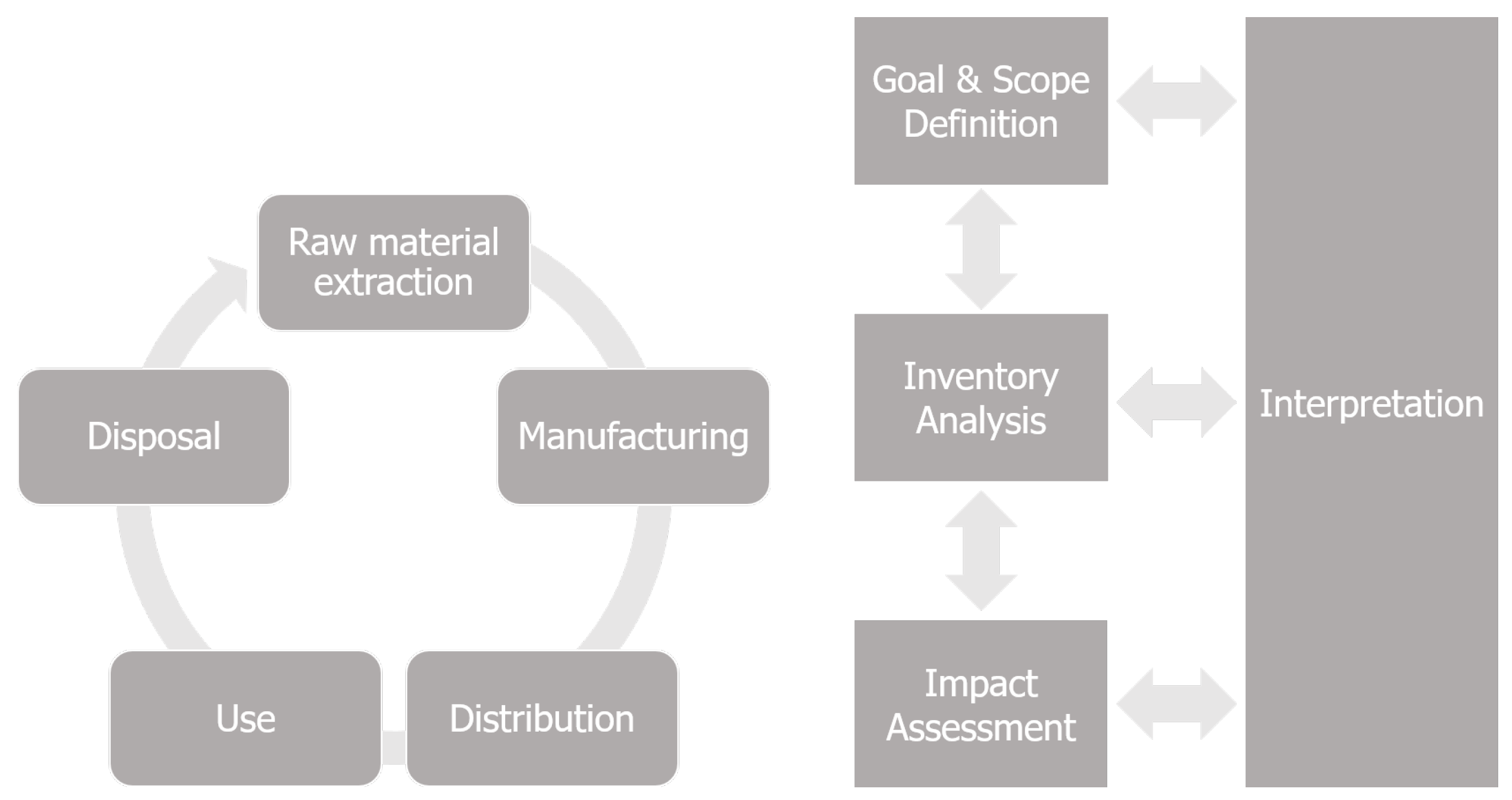



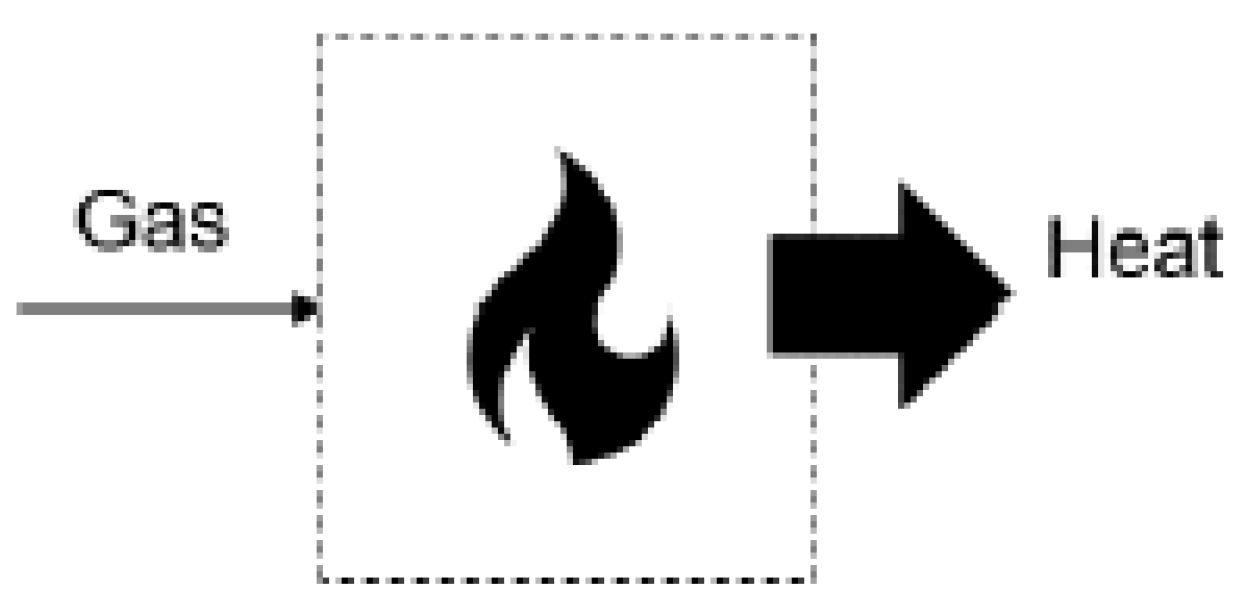




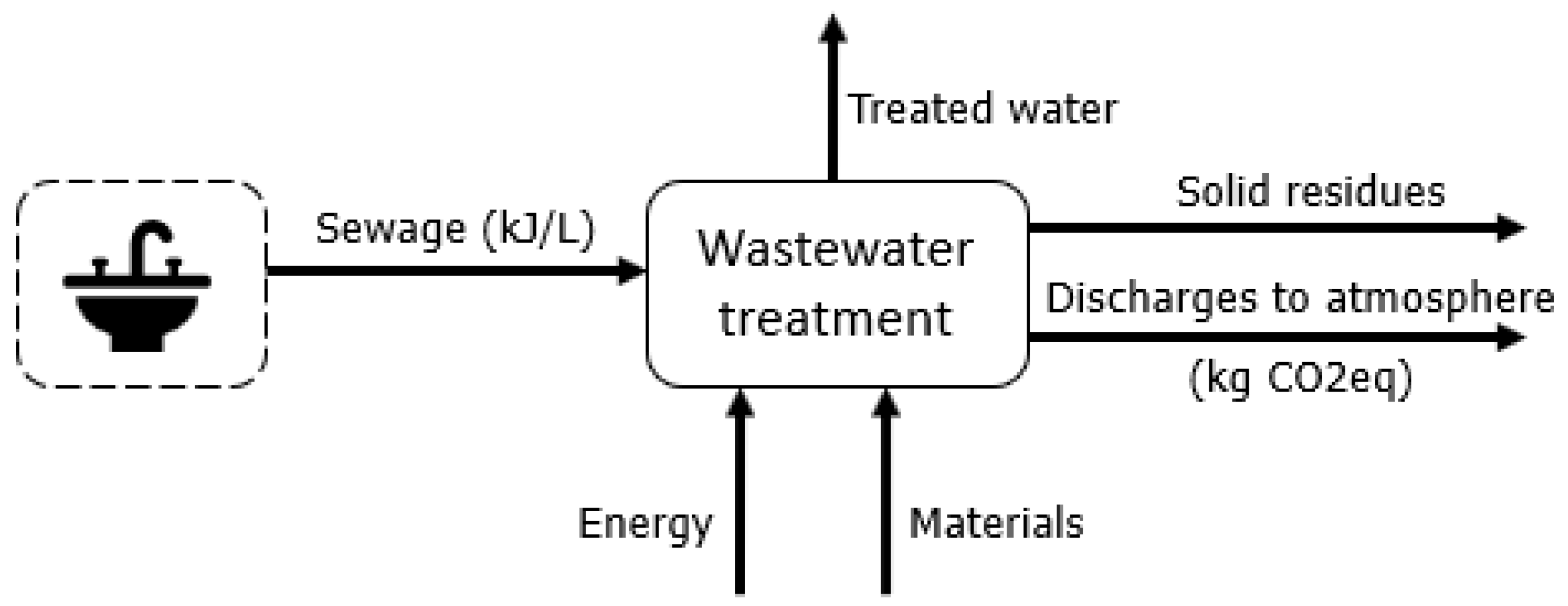
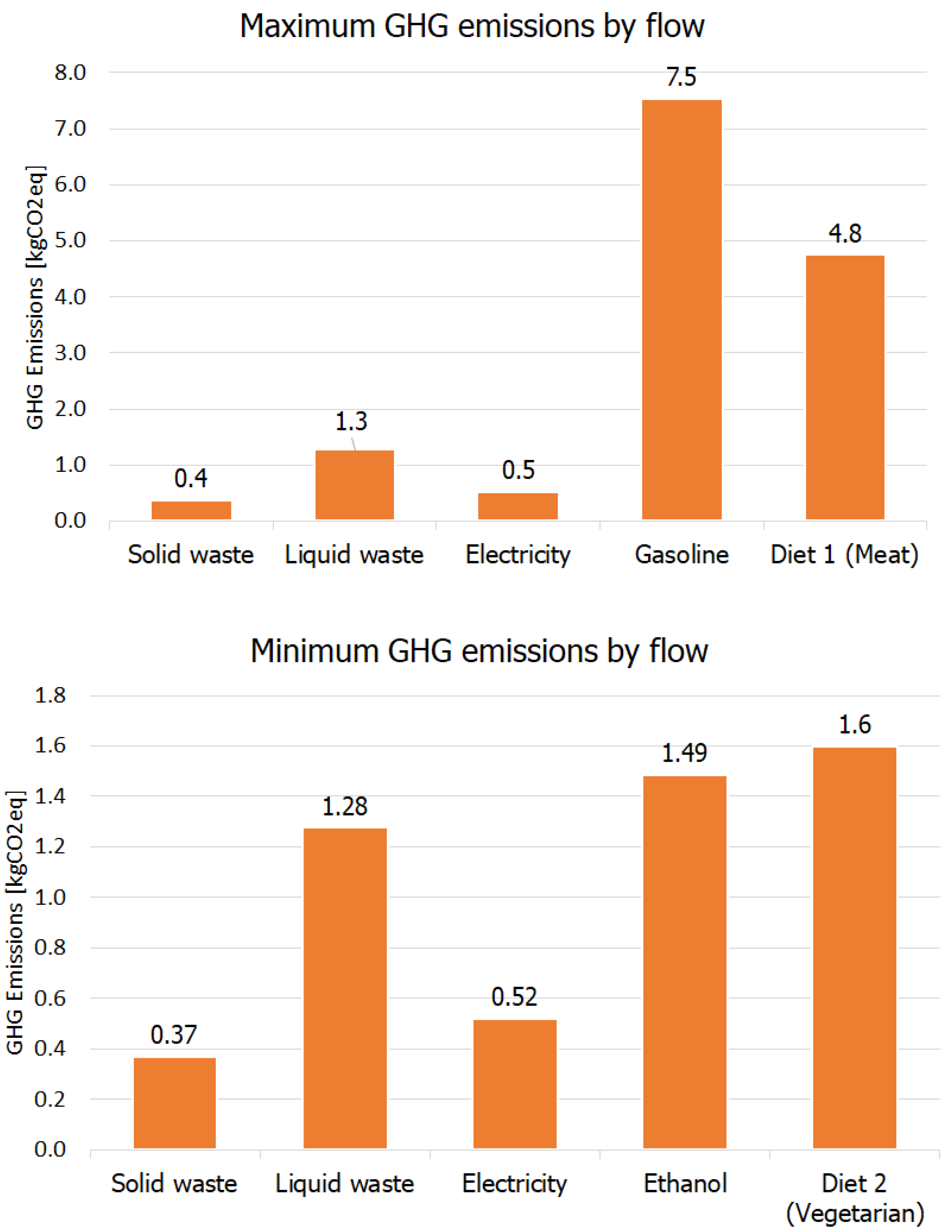
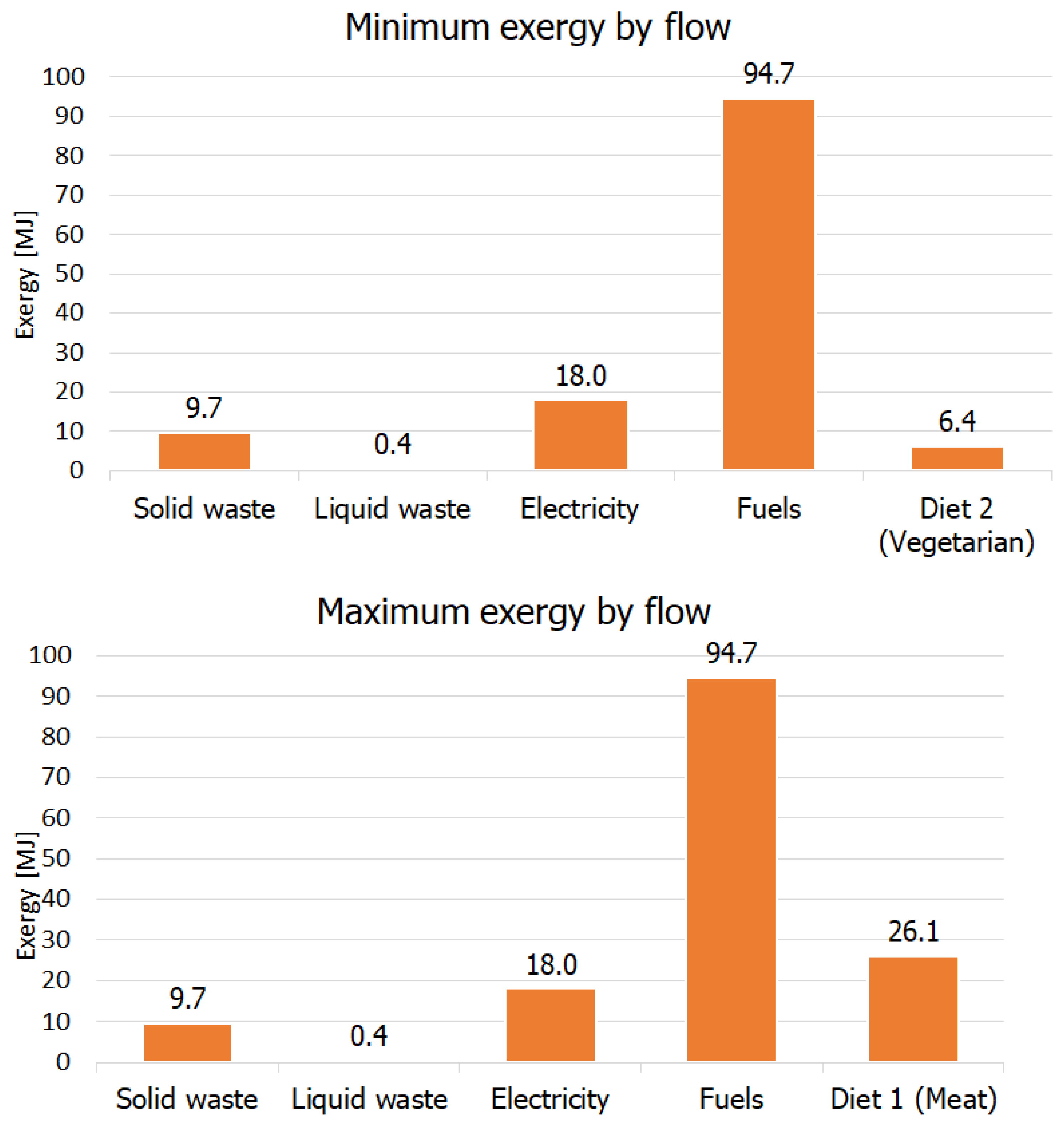


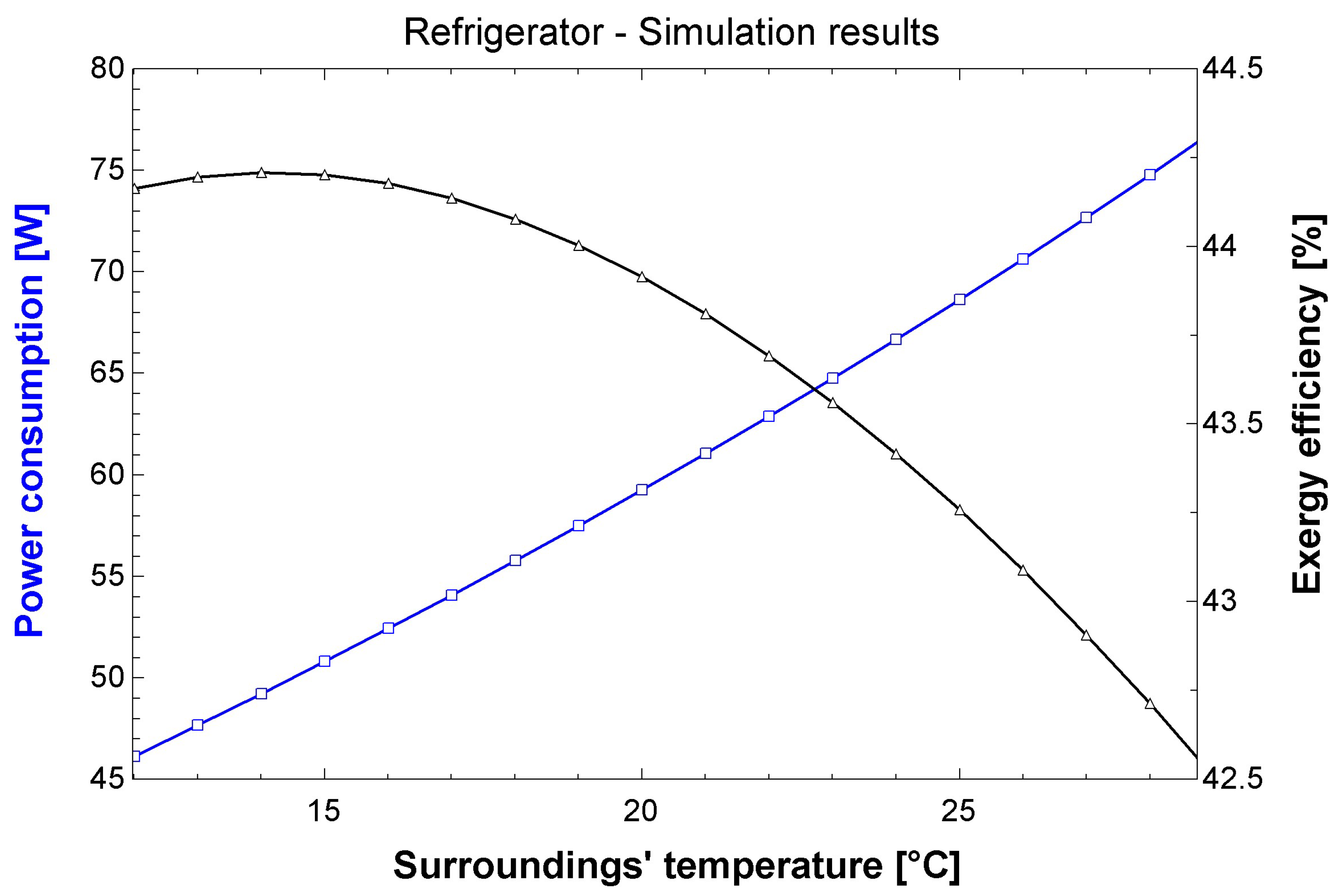
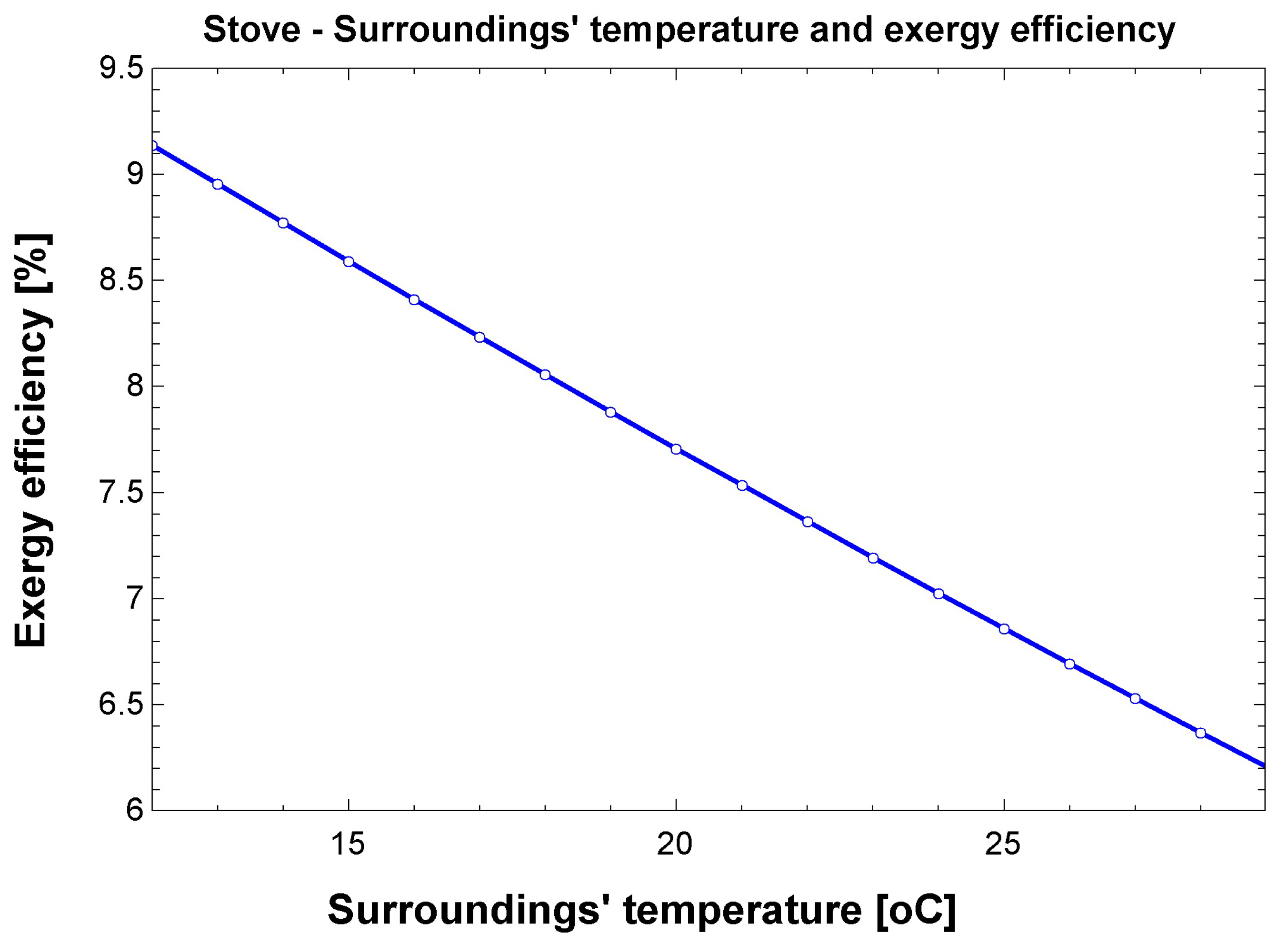
| Fuel | LHV (MJ/L) | GHG Emissions (gCO/km) |
|---|---|---|
| Gasoline | 28.9 | 159.83 |
| Ethanol | 21.3 | 31.53 |
| Diesel | 35.6 | 274.59 |
| Exergy [MJ] | Daily | Yearly (365 Days) |
|---|---|---|
| Max | 148.91 | 54,353 |
| Min | 129.22 | 47,166 |
| Avg | 139.07 | 50,760 |
| Zone | Average Official Consumption 2021 [kWh] | Estimated Consumption [kWh] | Difference [kWh] |
|---|---|---|---|
| North | 183 | 150 | 33 |
| Northeast | 130 | 150 | −21 |
| Southeast | 175 | 150 | 23 |
| South | 187 | 150 | 34 |
| Central-west | 154 | 150 | 39 |
| Scenario | Jan | Feb | Mar | Apr | May | Jun | Jul | Aug | Sep | Oct | Nov | Dec |
|---|---|---|---|---|---|---|---|---|---|---|---|---|
| Official [kWh] | 196 | 186 | 189 | 190 | 167 | 164 | 159 | 161 | 176 | 169 | 166 | 177 |
| Difference [kWh] | 46 | 36 | 39 | 40 | 17 | 14 | 9 | 11 | 26 | 19 | 16 | 27 |
Publisher’s Note: MDPI stays neutral with regard to jurisdictional claims in published maps and institutional affiliations. |
© 2022 by the authors. Licensee MDPI, Basel, Switzerland. This article is an open access article distributed under the terms and conditions of the Creative Commons Attribution (CC BY) license (https://creativecommons.org/licenses/by/4.0/).
Share and Cite
Pereira, M.T.R.M.; Carvalho, M.; Mady, C.E.K. Adressing Energy Demand and Climate Change through the Second Law of Thermodynamics and LCA towards a Rational Use of Energy in Brazilian Households. Entropy 2022, 24, 1524. https://doi.org/10.3390/e24111524
Pereira MTRM, Carvalho M, Mady CEK. Adressing Energy Demand and Climate Change through the Second Law of Thermodynamics and LCA towards a Rational Use of Energy in Brazilian Households. Entropy. 2022; 24(11):1524. https://doi.org/10.3390/e24111524
Chicago/Turabian StylePereira, Marina Torelli Reis Martins, Monica Carvalho, and Carlos Eduardo Keutenedjian Mady. 2022. "Adressing Energy Demand and Climate Change through the Second Law of Thermodynamics and LCA towards a Rational Use of Energy in Brazilian Households" Entropy 24, no. 11: 1524. https://doi.org/10.3390/e24111524
APA StylePereira, M. T. R. M., Carvalho, M., & Mady, C. E. K. (2022). Adressing Energy Demand and Climate Change through the Second Law of Thermodynamics and LCA towards a Rational Use of Energy in Brazilian Households. Entropy, 24(11), 1524. https://doi.org/10.3390/e24111524








